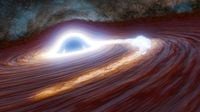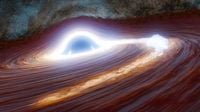In a cosmic spectacle that has left astronomers marveling, scientists have detected the brightest black hole flare ever recorded, a celestial event that outshines anything previously observed in the universe’s history. This extraordinary flare, first spotted in 2018 by a camera at the Palomar Observatory in California, radiated with the intensity of 10 trillion suns, according to a study published November 4, 2025, in Nature Astronomy.
The flare originated from the active galactic nucleus (AGN) J224554.84+374326.5, a supermassive black hole situated a staggering 10 billion light years away. That means the light from this event began its journey when the universe was still in its youth, offering scientists a rare window into the early cosmos. For context, a single light year is nearly 6 trillion miles—the scale here is almost unfathomable.
What exactly caused such a mind-boggling display? The favored explanation among researchers is that a massive star, weighing more than 30 times our sun, wandered too close to the black hole and was torn apart in a violent process known as tidal disruption. As the star was shredded, its material spiraled into the black hole’s accretion disk, unleashing a torrent of energy that brightened the AGN by more than a factor of 40. The total energy released in ultraviolet and optical light is estimated at about 1054 erg—roughly the complete conversion of a solar mass into pure electromagnetic radiation. That’s a number so large, it defies everyday comparison.
"At first, we didn't really believe the numbers about the energy," admitted study author Matthew Graham of the California Institute of Technology, which operates Palomar Observatory, as reported by the Associated Press and Nature Astronomy. The event’s peak brightness lasted about three months before slowly fading, and its gradual decline has continued in the years since its detection.
To put this flare’s power in perspective, it is 30 times more energetic than the previous record-holder for AGN transients—those sudden, dramatic outbursts of light from active galactic nuclei. According to Nature Astronomy, very few phenomena in the universe can produce such immense electromagnetic energy. The researchers considered other possible mechanisms, including gravitational lensing (where a massive foreground object bends and amplifies light from a background source) and even a supermassive supernova within the accretion disk. Still, the tidal disruption of a massive star remains the most plausible scenario.
Supermassive black holes like the one at the heart of J224554.84+374326.5 are not rare in the universe. In fact, almost every large galaxy—including our own Milky Way—hosts one at its center. These cosmic giants exert a gravitational pull so strong that they shape the swirl and structure of their entire host galaxy. Yet, despite their ubiquity, many mysteries about their origins and behaviors remain. As Nature Astronomy notes, scientists are still in the dark about how these behemoths initially form.
What makes this event particularly valuable to astronomers is its timing and distance. With the flare originating from a time when the universe was young, it offers a unique chance to study the early interactions between supermassive black holes and their environments. Joseph Michail of the Harvard-Smithsonian Center for Astrophysics, who was not involved in the study, told the Associated Press that such discoveries allow scientists "to probe the interaction of supermassive black holes with their environments early in the universe." These early cosmic encounters, researchers believe, helped shape the universe we inhabit today.
The process of tidal disruption is both dramatic and rare. When a star ventures too close to a black hole, the immense gravitational forces stretch and eventually rip it apart. The resulting debris forms a disk of superheated gas around the black hole, emitting powerful flares of light and energy as it spirals inward. According to the Nature Astronomy article, the star in this case was not just any star, but a high-mass one—over 30 times the mass of the sun—on a prograde orbit within the AGN’s disk. This detail is significant, as it helps explain the unprecedented scale of the flare.
The study’s authors, led by Matthew J. Graham, also weighed alternative explanations for the flare. Gravitational lensing, for example, can cause distant objects to appear brighter due to the bending of light by massive foreground objects. However, the observed characteristics of the flare did not fit this scenario. Similarly, the possibility of a supermassive (pair-instability) supernova—an explosion of a gigantic star in the accretion disk—was considered but ultimately deemed less likely.
Active galactic nuclei have long fascinated astronomers with their variability. Since their discovery over 60 years ago, AGNs have been recognized as highly dynamic environments, with brightness that can change due to shifts in accretion rates, temperature variations, and structural changes in their accretion disks. The extremes of this variability are only now being explored, thanks to advances in time-domain surveys and observatories like Palomar. This latest flare represents the most extreme example yet, expanding the boundaries of what scientists thought possible.
The research, published in Nature Astronomy, was a collaborative effort involving institutions from around the world. The Zwicky Transient Facility, operated at Palomar, played a crucial role in detecting and monitoring the flare. The study highlights the importance of international collaboration and cutting-edge technology in unraveling the universe’s deepest mysteries.
While this flare is the brightest and most powerful ever recorded, it’s not the only extraordinary black hole event to make headlines in recent years. In March 2024, astronomers announced the discovery of the oldest known supermassive black hole, dating back to when the universe was just 430 million years old. Another ancient black hole, found in 2023, formed around 13.2 billion years ago and dwarfs the Milky Way’s central black hole by a factor of ten. These discoveries, along with the record-breaking flare, are helping to piece together the history of black holes and their role in cosmic evolution.
For now, the flare from J224554.84+374326.5 continues to fade, but its legacy will linger in the annals of astronomy. As scientists sift through the data and refine their models, one thing is clear: the universe still holds surprises that can outshine even our wildest expectations.


